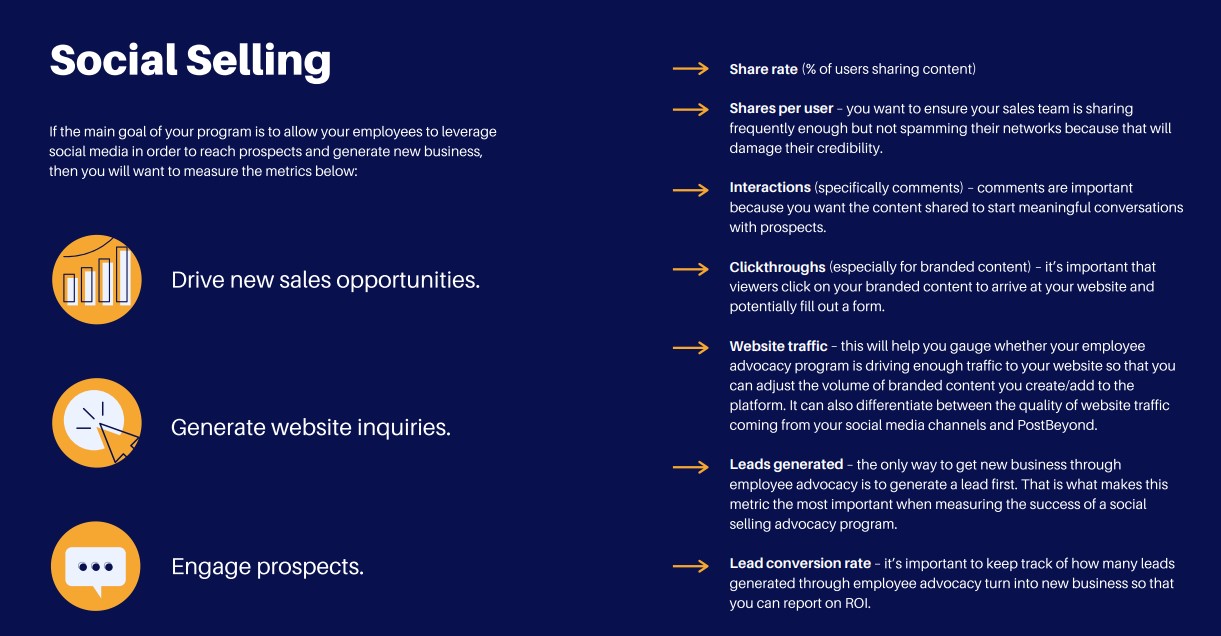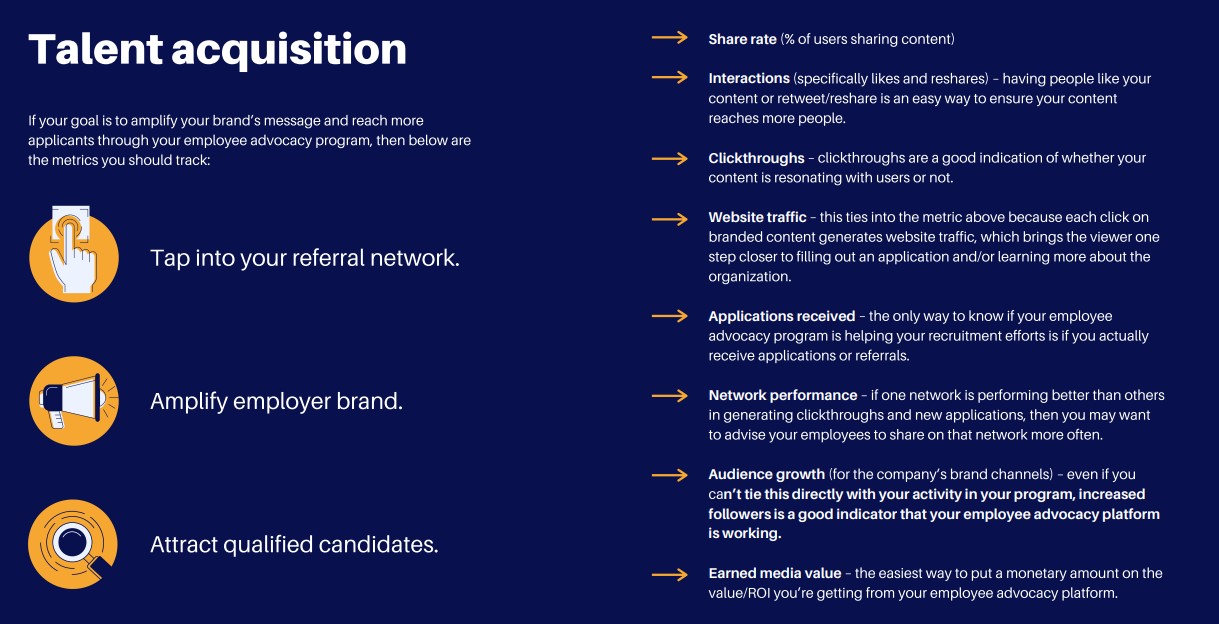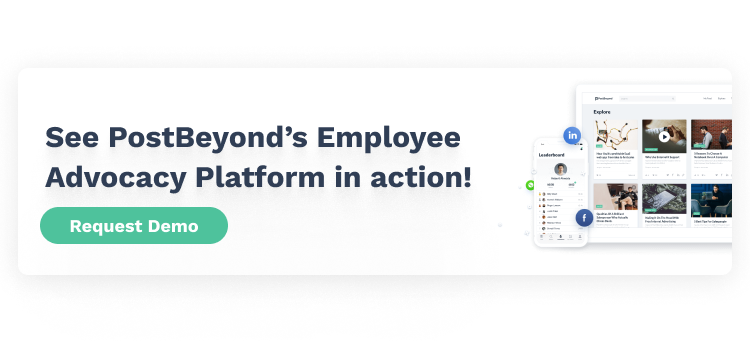8 Employee Advocacy Metrics for Measuring Your Program
Table of Contents:
Introduction
“If you can not measure it, you cannot improve it.”
Measuring your efforts is important for every area in marketing and employee advocacy is no exception.
The role of employee advocacy has progressed a lot in the past few years by leaning towards earning more accountability for results within organizations.
This involves moving the needle beyond just the number of shares, likes or comments; for most marketers, it’s all about engagement.
Having metrics is vital for the performance of your employee advocacy program. They can shed light on your social media and content performance and, more importantly, how your employees directly influence marketing efforts.
Companies that take a disciplined approach towards measurement have a competitive edge over those that don’t.
For scalable employee advocacy programs, the message is loud and clear: proper metrics lead to better performance and a clear path to scale.
Whether you’re just starting an employee advocacy program or scaling up, the metrics outlined in this guide will directly impact your results.
From social reach to adoption, clickthrough rates to website conversions, these metrics are yours to build a foundation for success.
If you’re monitoring all 8 KPIs, you’ve got the makings of a strong employee advocacy program.
And if not, then this guide will provide you with insight on what metrics to measure, why they’re
important, and how to measure them.
The Fundamental Differences in Employee Advocacy Metrics
Quality, Not Quantity
Social shares won’t generate a high quantity of leads. That’s why metrics such as marketing qualified leads become less useful.
In short, marketing needs to amplify its influence on social media with your employees’ social networks.
Employee advocacy metrics focus on the quality of the people your employees’ influence.
Focus on Engagement
Likes and retweets have their place in terms of social media metrics, but employee advocacy is about engagement.
A sales rep with 600 LinkedIn connections can’t rely on likes to drive sales – she needs to have conversations with her prospects. More importantly, she needs to know how social engagement leads to sales outcomes.
Which scenario would your sales reps value more – 20 likes from random connections, or 5 meaningful conversations with relevant buyers, decision-makers, or qualified job candidates?
Sharing Matters
Universally agreed upon by all of the employee advocacy program managers, the most important metric they care about is share-rate.
If employees aren’t sharing content then it’s likely that your content is irrelevant or they don’t know how to share.
By focusing on share-rate, you can determine what changes need to be made.
Sharing is also a leading indicator of engagement because without shares, there aren’t any posts live on social media.
Impact Marketing
You need a way to measure the impact of employee advocacy on overall efforts.
Ideally, you’re able to measure every single marketing effort from the top to the bottom of your funnel. However, this isn’t the case. The right tools are needed to measure outcomes.
So, it’s key to have website analytics, marketing automation, and CRM to understand the journey of your leads. You also need social listening tools to determine your share of voice (SoV) and brand sentiment.
Why Employee Advocacy Metrics Matter

Metrics are the foundation on which employee advocacy is built on. You need to know what you consider success and how you’re going to measure it before launching a program.
Here are some other reasons why metrics are important:
- Allow you to track how your program is progressing over time.
- Benchmark with similar organizations in your industry or company size to see how you compare.
- Use quantifiable results and ROI to communicate success and get buy-in from executives.
Now that we have established why metrics are important, let’s talk about what are the most important metrics you should use.
There is no straightforward answer to that question because it all depends on what your objectives are for your employee advocacy program.
However, the one metric that is universally used and cared about across all of our customers is share rate (which is the % of users sharing content).
8 Core Employee Advocacy Metrics
1. Employee Adoption

What is it?
Employee adoption is a mission-critical metric for program admins.
Ensuring your employees are logging in to your platform to share content is a leading indicator for lagging metrics such as share rate, engagement, and website traffic.
Getting employees active matters most. If your adoption is high then your employees understand the value of advocacy and are keen on using it.
As a program admin, it’s your mission to internally market your employee advocacy program.
This will ensure your employees are aware of the program and consistently log-in.
If you have strong employee adoption, then your platform will become the go-to source for content. It becomes a part of your employees’ daily workflow, which leads to an upward trend for share rate.
How to Measure Employee Adoption
Employee adoption is the total number of active users (e.g., logged in) compared to the total number of users invited to the program.
2. Share-Rate

What is it?
As with any new technology, not every employee will log-in or use it every single day.
As a result, the share rate will gradually drop lower as time goes by.
There could be a few reasons this is happening.
Perhaps the content isn’t fresh and relevant, or employees simply are uncomfortable using social media. Often, the fear of social media can hold employees back from sharing.
That’s why measuring your share rate is essential to diagnose what’s encouraging or discouraging your employees from advocacy.
Share-rate is a universally used metric for employee advocacy and it is the most essential metric measured by our customers.
For the best results, you need to build a structured plan which involves a consistent flow of fresh content, gamification, training, and support.
Pay attention to the social savviness amongst your employees because you’ll want to ensure everyone understands how to post content on social media correctly.
How to Measure Share-Rate
Share-rate is the total number of shares by an employee compared to total active users.
3. Potential Reach

What is it?
In today’s social media landscape, there are thousands of messages shared on social media.
With so much content out there, it’s vital that your social posts are seen by your target audience.
If your content doesn’t reach the right people then it fails to deliver on engagement. The more social connections see your content, the higher the chance they’ll engage, and the better the chance they’ll convert on your website.
Similar to other metrics, it’s essential to measure potential reach along with other employee advocacy KPIs. If you have a potential reach of 1,000, yet your engagement rate is low, then it’s time to adjust your content strategy to ensure it’s relevant for your network or connect with more like-minded social followers.
How to Measure Potential Reach
Potential reach is an estimate of the number of people in your audience on social media to connect with every time you share a piece of content.
4. Interactions

What is it?
An interaction is when a follower, friend, or connection in your social network interacts with the content you’ve shared.
The interaction could be likes, favorites, shares, retweets, replies, comments or clicks on your shared link. For example, you can determine the number of interactions your posts have received by how many people clicked or retweeted the content.
How to Measure Interactions
It is measured by taking the number of interactions made with the content that an employee has posted in a given timeframe. For example, one employee receives 27 interactions (likes, comments, retweets) within 30 days.
5. Earned Media Value

What is it?
Earned Media Value (EMV) is the dollar amount saved to get the same amount of people to view your content through paid media.
It is the amount that your company would spend on paid advertisements to drive the equivalent amount of engagement.
The dollar value impact is directly inspired by your employee’s social engagement.
Customers use EMV as one of many key metrics to calculate their brand’s online word-of-mouth and ROI. EMV alone can provide a good indicator of how well your branded content performs.
Our recommendation is to measure it as part of overall employee advocacy reporting.
How to Measure Earned Media Value
In short, EMV is measured by the total potential reach multiplied by an equivalent cost per impressions (CPM).
6. Click-Throughs

What is it?
Click-through rate (CTR) measures how many people clicked on a social post shared by an employee. This indicates how compelling your social content is to drive a visitor.
The main goal of tracking click-throughs is to measure engagement. It’s important if your employees are sharing third-party content because you’ll need a way to determine if people are reading this content. You’ll be able to understand:
- Website traffic
- Website conversion
- Engagement rate
How to Measure Click-Throughs
Click-throughs can be measured by taking the total number of clicks your content received.
Clickthrough = Total Measured Clicks / Total Measured Reach x 100
Measuring click-throughs is an excellent indicator of content quality; however, if visitors aren’t converting into leads, then what’s the point? By measuring click-throughs with website traffic and conversion rates, you’ll understand how content converts a social connection into a customer.
7. Website Traffic

What is it?
You can have the perfect engagement rates and reach a wide audience, but none of it will matter if nobody visits your website.
Monitoring your website traffic is important for the success of your employee advocacy program. Even more so when your employees are sharing branded content.
Most importantly: focus on the type of content that leads to higher website traffic. Paying attention to trends and how they relate to this metric can give you a leg up when it comes to future content calendars.
How to Measure Website Traffic
If your website has an analytics tool installed (e.g., Google Analytics or Adobe Analytics), then you’ll see close to exact website traffic numbers.
Primarily within a website analytics tool, you can filter website traffic from various sources or campaigns.
The best way to measure the total website traffic from employee advocacy is to apply a campaign report that filters visitors to just visitors sourced from employee shared content.
8. Conversion Rate

What is it?
Conversion rate is one of the best metrics to measure for your website performance. Your conversion rate is the percentage of visitors to your website that have converted.
Conversion depends on your business goals and can include:
- Website registration
- White-paper download
- Requesting a consultation or demo
- Submitting a contact us form
- Engaging with your website chatbot
- Subscribing to your blog
How to Measure Conversion Rate
Conversion rate is measured by taking the number of conversions in a given time by the total number of people who visited your website or landing page and then multiplying by 100%.
For example, if your webinar landing page had 9,000 visitors and 2120 conversions in the past 30 days, your conversion rate would be 23.56%.
Conversion rate = (conversions/total visitors) * 100%.
Analytics platforms (e.g., Google Analytics or Adobe Analytics) can show conversation rates within their reporting.
Employee Advocacy Metrics by Use Case
Thought Leadership
If the objective of your employee advocacy program is to build thought leadership through enabling employees to establish their industry expertise, amplify content and spark engagement then the metrics below are what you should measure.
- Amplify your brand message
- Build thought leadership
- Spark engagement

Social Selling
If the main goal of your program is to allow your employees to leverage social media in order to reach prospects and generate new business, then you will want to measure the metrics below:
- Drive new sales opportunities
- Generate website inquiries
- Engage prospects

Talent Acquisition
If your goal is to amplify your brand’s message and reach more applicants through your employee advocacy program, then below are the metrics you should track:
- Tap into your referral network
- Amplify employer brand
- Attract qualified candidates

The Importance of Having Employee Advocacy Benchmarks
One common question that comes up is, “how does my employee advocacy program compare with others like us?” Use industry benchmarks for a clearer picture of how your program compares.
Essentially, benchmarking data helps companies compare their process and performance metrics to industry bests or to similar companies. In most cases, benchmark data can be segmented by industry, company size, or use case.
Every employee advocacy program wants to be the best and nobody wants to see their performance lagging against their peers. Who has the highest adoption rate or engagement rate? Benchmarking data brings competitiveness out of customers.
Benchmarks help you improve your program’s efficiencies with fresh new ideas, best practices, and processes that similar companies are succeeding with.
Next Steps
We hope this guide helped you understand how to measure core metrics and deliver maximum results for your employee advocacy program.
As more organizations ingrain social media and employee advocacy within their brand, marketers will need better visibility into how it impacts their marketing efforts.
To do so, you need the right metrics and data to make an informed decision.
The traditional way to measuring success with the likes, comments and retweets aren’t enough to garner accountability anymore. If you’re going to embrace employee advocacy, then you’ll need to understand the full lifecycle of how to successfully measure results.
An employee advocacy program based on the wrong metrics will consequently lead to the wrong outcomes.

Turn your employees into advocates
Measure Your Employee Advocacy Program With PostBeyond

